AI-Driven Cloud RRM Overview
AI-Driven Cloud Radio Resource Management (RRM) is a centralized algorithm that runs in the RUCKUS Analytics cloud and guarantees zero interfering links for the access points (APs) managed by SmartZone controllers, whenever theoretically achievable thus minimizing co-channel interference to the lowest level possible. This is accomplished by continuously gathering RF data from all the access points, holistically analyzing the RF environment and usage patterns, and jointly making optimal choices for channel re-use, channel bandwidth, and AP transmit power selection to maximize the network throughput. This new technology relies on sophisticated techniques of machine learning, artificial intelligence, graph algorithms, and cloud scale computation to jointly optimize channel, channel width, and AP transmit power. This method goes beyond adjusting the channel width because it optimizes across all combinations of channel, channel width, and AP transmit power to search for the optimal values across the network.
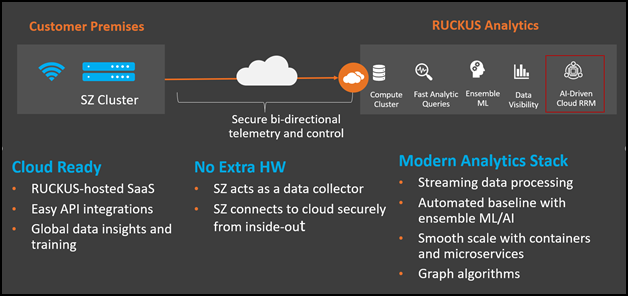
Benefits of AI-Driven Cloud RRM for an End User
With the introduction of AI-Driven Cloud RRM, customer Wi-Fi client devices can expect to operate in interference-free RF conditions, when possible, and experience higher throughput and higher reliability with fewer retries and errors. This results in higher user satisfaction when connecting wirelessly to the network. Maximizing the channel bandwidth allocation in the interference-free environment also ensures optimal performance to support high-throughput and low latency applications.
Advantages of AI-Driven Cloud RRM for a Network Administrator
While professional wireless engineers routinely optimize their network performance by selecting channel and power settings in addition to tuning other available configuration knobs, this task is getting more difficult with the advent of 6 GHz spectrum. A glance at the newly introduced spectrum and the available channel and channel width options make it tedious to manually optimize channel and channel width parameters required for a properly tuned Wi-Fi network. Not all enterprises have the wireless RF professionals available to tune these settings across the network. For a busy network administrator, sub-optimal conditions often go undiscovered until an end-user escalation.
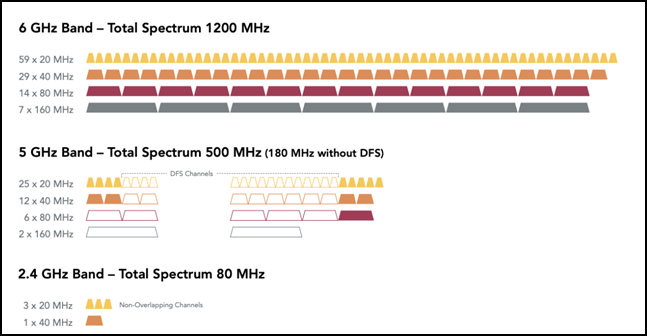
With AI-Driven Cloud RRM, network conditions are continuously monitored. When there is an opportunity to improve upon a sub-optimal configuration, the network administrator is presented with an optimized choice of channel and channel width in the form of an AI recommendation. With a single click, the network administrator can make changes to the network and apply the most optimal parameters to all the APs in a zone.
How AI-Driven Cloud RRM Works
AI-Driven Cloud RRM analyzes interference information received from every AP in the network, the user configuration hierarchy, access point capability, historical data about access point radio activity, rogue access points, and traffic patterns to jointly optimize channel, channel width, and AP transmit power.
 (Recommendation Details) icon displays the explainable AI
recommendation, where the network administrator can find more information: what is this
recommendation, why is it being made, and what are some of the potential trade-offs.
Available actions include Apply, Revert, and Mute.
(Recommendation Details) icon displays the explainable AI
recommendation, where the network administrator can find more information: what is this
recommendation, why is it being made, and what are some of the potential trade-offs.
Available actions include Apply, Revert, and Mute. 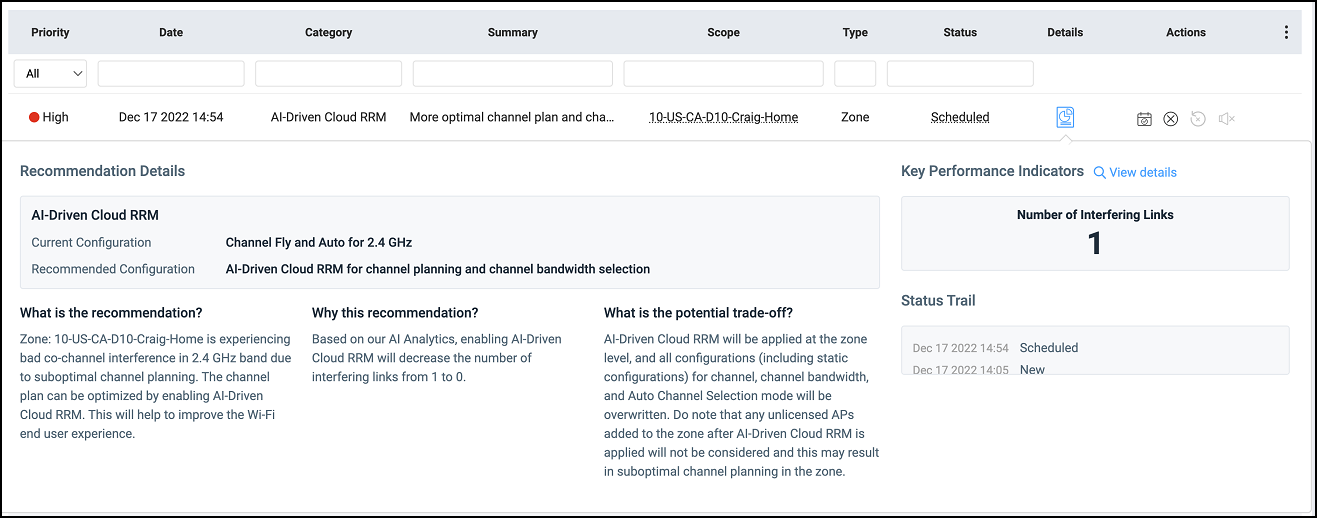
When a network administrator clicks the
 (Apply)
icon available in the Actions column against each recommendation, a
scheduling calender is displayed to select a date and time for the channel and channel width
changes to be applied. This gives control to the network administrator to pick off-peak
hours when the network is less busy to make the change. Changes are applied at the chosen
time using SmartZone API calls to the controller from RUCKUS Analytics, and the scheduled
time is stored in the system and used for future changes to channel and channel width if
required.
(Apply)
icon available in the Actions column against each recommendation, a
scheduling calender is displayed to select a date and time for the channel and channel width
changes to be applied. This gives control to the network administrator to pick off-peak
hours when the network is less busy to make the change. Changes are applied at the chosen
time using SmartZone API calls to the controller from RUCKUS Analytics, and the scheduled
time is stored in the system and used for future changes to channel and channel width if
required.
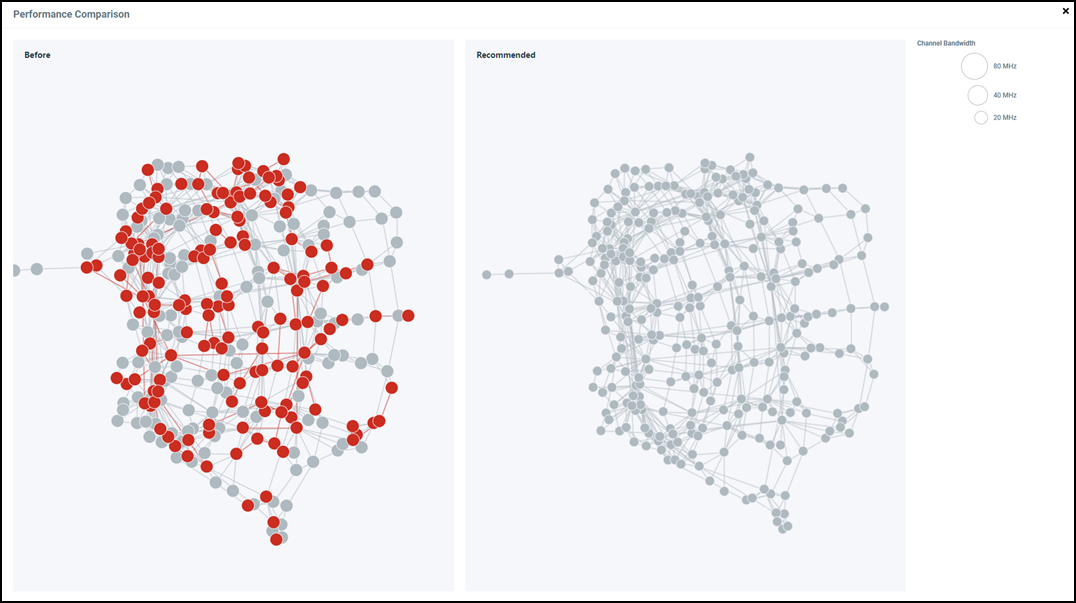
After the AI-Driven Cloud RRM recommendation is applied, it is pinned in the list of recommendations. If the network administrator reverts the recommendation, the original configuration is restored. Once the recommendation is applied, the KPI panel moves into the monitoring state for 24 hours where AI-Driven Cloud RRM starts gathering feedback about the change that was recently applied. The AI-Driven Cloud RRM is always active and any subsequent changes to the RF network, if required, are made at the selected time.
AI-Driven Cloud RRM Considerations
- When an AI-Driven Cloud RRM recommendation is applied, changes are made to RF parameters that overwrite previous configurations. If a ChannelFly configuration was previously selected for channel selection at the zone, the configuration moves under the control of AI-Driven Cloud RRM, and ChannelFly is disabled.
- The background scanning configuration and scanning interval is not changed, but continues to operate collecting data to discover the RF neighborhood that is used for seamless roaming, rogue AP detection, and AI-Driven Cloud RRM algorithms.
- AI-Driven Cloud RRM will overwrite existing static manual configurations except ApRadioDeploy and ChannelRange. If a static manual configuration is detected, RUCKUS Analytics flags this in the recommendation itself with corresponding warnings. This allows the network administrator to decide whether to override the static manual configuration by activating AI-Driven Cloud RRM.
- AI-Driven Cloud RRM does not co-exist with manual override or intervention after the AI-Driven Cloud RRM recommendation is applied. Network administrator must disable AI-Driven Cloud RRM completely to have manual override for a subset of APs in a zone.
- AI-Driven Cloud RRM enables rogue detection at the zone level. This is done to gather a complete RF picture of the environment before optimization decisions are made.
- AI-Driven Cloud RRM recommendations are triggered only for zones with 100 percent licensed APs. Any unlicensed APs added to the zone after AI-Driven Cloud RRM is applied are not considered, which may result in sub-optimal channel planning in the zone.
- In this release, AI-Driven Cloud RRM does not operate when zones have mesh configuration enabled.
- AI-Driven Cloud RRM requires SmartZone controller release 5.2.2 and later. All access points supported on this release are compatible.
- SmartZone controllers that are already onboarded to RUCKUS Analytics can immediately begin using AI-Driven Cloud RRM. For systems that are newly onboarded, AI-Driven Cloud RRM can be used immediately; however, the system improves in performance as historical information accumulates.
- AI-Driven Cloud RRM recommends channel
and channel width configuration items at the zone level. Network Administrator is
required to pick a date and time to apply the configuration. This is the local time for
the zone for which recommendation is made. It is a best practice to include access
points in the same time zone in a SZ zone because off-peak hours might differ across
time zones.Note: If the RUCKUS Analytics license is removed or expired, the last run AI-Driven Cloud RRM configuration will be used, and the channel plan will be set to static and not ChannelFly or Background Scanning.Note: If a user reverts RUCKUS Analytics AI-Driven Cloud RRM recommendation, the original channel selection method is restored, and the recommendation will not resurface for 90 days.
AI-Driven Cloud RRM Behavior in 2.4 GHz
It is generally accepted and understood that 2.4 GHz is a crowded spectrum with only 3 non-overlapping channels. However, it is important because several clients still only support 2.4 GHz band. RF propagation characteristics unique to 2.4 GHz make it a useful choice due to its increased range.
Since 2.4 GHz band has only 3 non-overlapping channels - 1, 6, and 11 - it is likely that APs in this band will hear other APs and zero interfering links solution does not exist in dense AP deployments in 2.4 GHz. In this scenario, AI-Driven Cloud RRM will still guarantee lowest possible co-channel interference. It does not take action to turn off AP radios in 2.4 GHz band.
AI-Driven Cloud RRM with Dynamic Frequency Selection (DFS) Channels
AI-Driven Cloud RRM is aware of the constraints that DFS channels pose in 5 GHz spectrum usage. While the actual decision to operate in DFS channel is still done at an AP radio level after radar detection measures have been applied, AI-Driven Cloud RRM keeps track of radar activity on different DFS channels and intelligently crowd source this information across multiple APs within the same physical proximity. Based on this crowd sourced information, AI-Driven Cloud RRM may restrict the use of some of these DFS channels to avoid disruptions to end users. Of course, optimality in terms of zero interfering links and channel bandwidth selection will still be maintained.
AI-Driven Cloud RRM Operation at Zone and AP Level

AI-Driven Cloud RRM Interoperability in a Mixed AP Deployment
The AI-Driven Cloud RRM algorithm works on the information it receives from RUCKUS access points. Any third-party access point is treated as a rogue AP. These data points are fed into the computation to search for the best option for channel and channel width. These changes are recommended to the network administrator using the AI recommendation mechanism. There is no deauthentication action taken against rogue APs because the algorithms have built-in rogue AP avoidance. Even in presence of rogue access points or third-party access points, AI-Driven Cloud RRM delivers the most optimum solution for interfering AP links and co-channel interference possible.
AI-Driven Cloud RRM AP Transmit Power
In high-density deployment scenarios, an ideal channel plan with no interfering links may not be achievable. To address this, the AI-driven Cloud RRM automatically detects the residual co-channel interference and provides recommendations for further reducing the interference by reducing the AP transmit power, while at the same time, ensuring that no coverage holes will be created. This reduces the possibility of neighboring APs interfering with each other's signals, resulting in an enhanced Wi-Fi end-user experience.
The image below displays an example of Cloud RRM AP Transmit Power Recommendation to reduce the AP transmit power in two APs to reduce the interfering links from three to one.
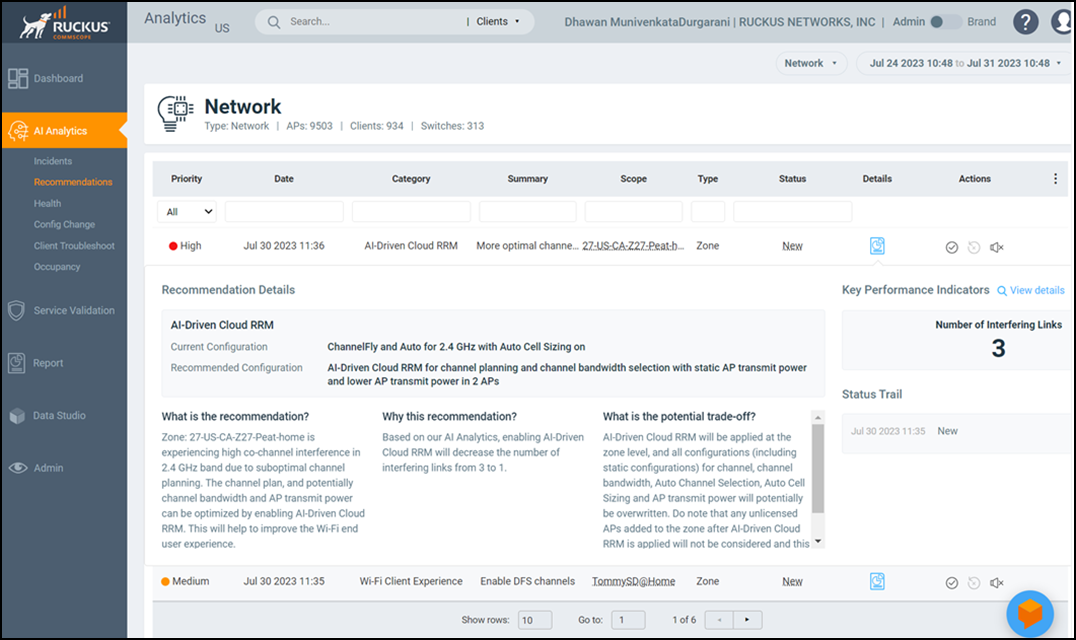
- Click the View
details icon to display the Performance Comparison
page, which shows the image of interfering links before and after the
recommendation.
CRRM Tx Power Comparison Page 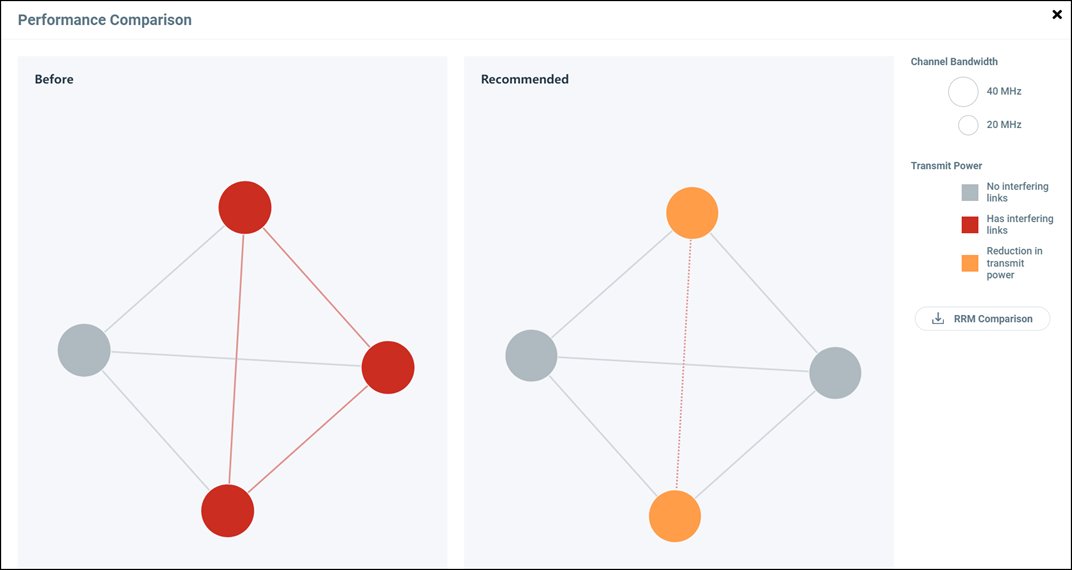
- Click RRM Comparison icon to download the Cloud RRM recommendation report in CSV format.
There are two types of recommendations that offer Tx power guidance to the user. The Wi-Fi client experience category of recommendations guides a user to adjust the Tx power setting for 2.4 and 5 GHz radios, mainly to encourage clients to move to a 5 GHz radio instead of a 2.4 GHz radio. This recommendation is also useful when APs have mesh networking enabled. While both recommendations may offer guidance about Tx Power, AI-Driven Cloud RRM recommends channel, channel width, and transmit power of radios to holistically reduce co-channel interference and maximize network throughput.